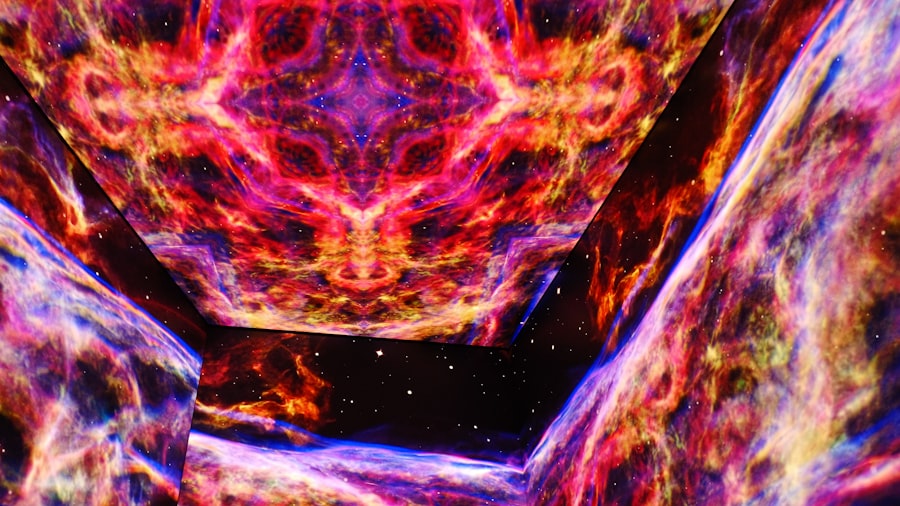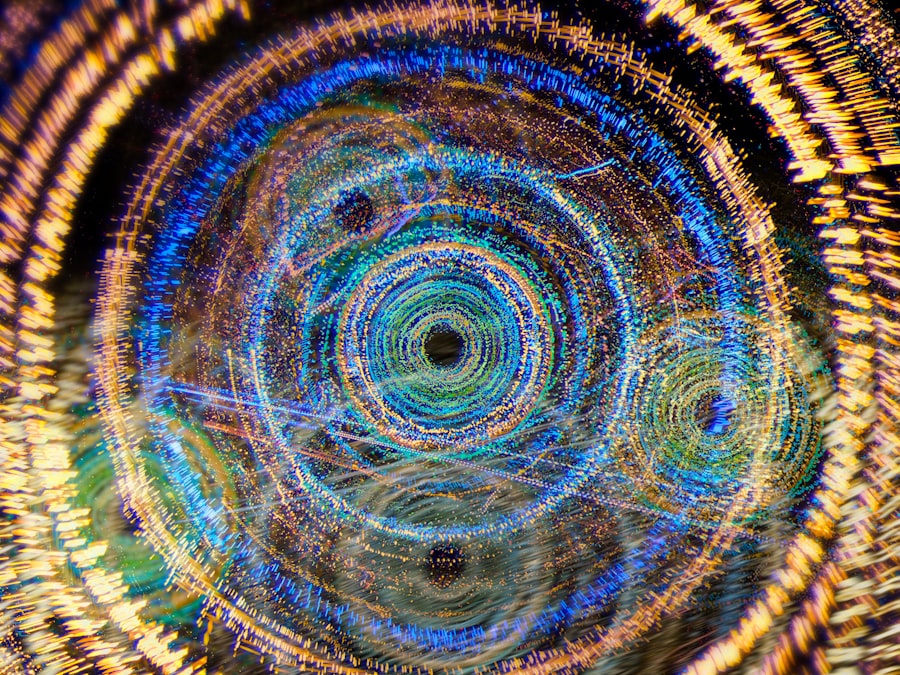As you delve into the fascinating intersection of biology and quantum physics, you may find yourself captivated by the concept of microtubules and their potential role in consciousness. Microtubules are cylindrical structures made of tubulin proteins, forming part of the cytoskeleton in cells, particularly neurons. They are not merely structural components; they play a crucial role in various cellular processes, including intracellular transport and cell division.
However, their significance extends beyond the physical realm, as some researchers propose that microtubules may be integral to understanding consciousness itself. The idea of quantum consciousness suggests that the mind may operate on principles of quantum mechanics, a field that describes the behavior of particles at the smallest scales. This theory posits that consciousness arises from quantum processes occurring within microtubules.
As you explore this intriguing hypothesis, you will uncover a blend of neuroscience and quantum physics that challenges traditional views of consciousness and invites you to reconsider the very nature of your own awareness.
Key Takeaways
- Microtubules are key cellular structures in the brain potentially involved in quantum information processing.
- Quantum consciousness theories propose that quantum coherence within microtubules contributes to conscious experience.
- Orchestrated Objective Reduction (Orch-OR) theory links microtubule quantum states to moments of conscious awareness.
- Microtubules may play a role in anesthesia and altered states by affecting quantum processes in the brain.
- Understanding microtubule quantum dynamics could open new avenues for research and applications in neuroscience and consciousness studies.
The Structure and Function of Microtubules in the Brain
Microtubules are essential components of the cytoskeleton, providing structural support to cells and facilitating intracellular transport. In neurons, these tubular structures are particularly abundant, forming a complex network that helps maintain the shape of the cell and supports the transport of organelles and proteins along axons and dendrites. This transport is vital for neuronal function, as it ensures that neurotransmitters and other essential molecules reach their intended destinations.
Beyond their structural role, microtubules are involved in signaling pathways that influence cellular behavior. They interact with various proteins to regulate cell growth, division, and communication. In the brain, where billions of neurons communicate with one another, the proper functioning of microtubules is crucial for maintaining cognitive processes.
As you consider the intricate workings of microtubules, you may begin to appreciate how these tiny structures could play a significant role in the larger context of consciousness.
Quantum Consciousness: A Brief Overview

Quantum consciousness is a provocative concept that suggests consciousness may arise from quantum phenomena rather than solely from classical biological processes. This theory challenges the conventional understanding of how thoughts and awareness emerge from neural activity. Instead, it posits that consciousness could be a fundamental aspect of the universe, intricately linked to quantum mechanics.
At its core, quantum consciousness proposes that the brain operates not just as a classical computer but as a quantum system capable of processing information in ways that classical systems cannot. This perspective opens up new avenues for understanding how subjective experiences arise from physical processes. As you explore this idea further, you will encounter various theories and models that attempt to bridge the gap between neuroscience and quantum physics, each offering unique insights into the nature of consciousness.
The Role of Microtubules in Quantum Information Processing
| Metric | Description | Value/Range | Unit | Relevance to Quantum Information Processing |
|---|---|---|---|---|
| Microtubule Length | Average length of microtubules in neurons | 1-10 | micrometers | Determines the scale of quantum coherence regions |
| Quantum Coherence Time | Duration microtubules maintain quantum coherence | 10^-6 to 10^-3 | seconds | Critical for sustaining quantum states for processing |
| Dipole Moment of Tubulin | Electric dipole moment of tubulin dimers | 100-200 | Debye | Influences quantum state interactions within microtubules |
| Energy Gap | Energy difference between quantum states in tubulin | 0.1-1 | eV | Determines feasibility of quantum transitions |
| Temperature Range | Temperature at which quantum effects are observed | 273-310 | Kelvin | Biological temperature range supporting quantum coherence |
| Quantum Entanglement Length | Distance over which entanglement is maintained | 100-1000 | nanometers | Impacts information transfer within microtubule networks |
| Signal Propagation Speed | Speed of quantum signal transmission along microtubules | 10^3-10^5 | meters/second | Relevant for timing in quantum information processing |
One of the most compelling aspects of the quantum consciousness theory is the proposed role of microtubules in quantum information processing. Researchers like Stuart Hameroff and Roger Penrose have suggested that microtubules may serve as sites for quantum computations within neurons. This idea stems from the observation that microtubules can exhibit quantum behavior under certain conditions, potentially allowing them to process information in ways that classical neurons cannot.
In this framework, microtubules could facilitate a form of information processing that transcends traditional neural activity. By harnessing quantum effects such as superposition and entanglement, microtubules might enable complex cognitive functions and contribute to the emergence of consciousness. As you contemplate this possibility, consider how it challenges your understanding of the brain’s capabilities and invites you to explore the potential for a deeper connection between mind and matter.
Quantum Coherence and Microtubules
Quantum coherence refers to the phenomenon where particles exist in multiple states simultaneously until measured or observed. This principle is central to many quantum processes and has significant implications for understanding consciousness. In the context of microtubules, coherence may play a vital role in facilitating communication between different parts of the brain.
When microtubules maintain a state of coherence, they could enable neurons to work together more effectively, enhancing cognitive functions such as memory and perception.
As you explore this concept further, consider how quantum coherence could reshape your understanding of how your brain processes information and experiences.
Orchestrated Objective Reduction: The Quantum Consciousness Theory

The theory of Orchestrated Objective Reduction (Orch-OR), proposed by Hameroff and Penrose, offers a framework for understanding how quantum processes within microtubules might give rise to consciousness. According to this theory, consciousness arises from orchestrated events occurring at the quantum level within microtubules. These events are thought to be influenced by both biological processes and fundamental aspects of reality.
In Orch-OR, objective reduction refers to the collapse of quantum states into definite outcomes, which is posited to occur in a way that is orchestrated by biological processes within neurons. This orchestration could lead to moments of conscious experience as quantum states collapse into specific thoughts or perceptions. As you consider this theory, reflect on how it integrates elements of both neuroscience and quantum physics, offering a novel perspective on the nature of consciousness.
The Quantum Mind: Integrating Microtubules into Consciousness
The concept of the “quantum mind” suggests that your conscious experience may be deeply intertwined with quantum processes occurring within your brain’s microtubules. This perspective challenges traditional views that regard consciousness as merely an emergent property of complex neural networks. Instead, it posits that your awareness may be fundamentally linked to the behavior of particles at the quantum level.
By integrating microtubules into our understanding of consciousness, we can begin to appreciate how your subjective experiences might arise from intricate interactions between biological structures and quantum phenomena. This integration invites you to reconsider what it means to be conscious and how your mind operates on both macroscopic and microscopic levels.
The Quantum Brain: How Microtubules Enable Consciousness
As you explore the idea of a “quantum brain,” consider how microtubules might enable consciousness through their unique properties. These structures are not only essential for cellular function but also possess characteristics that allow them to engage with quantum mechanics. The potential for microtubules to facilitate quantum information processing suggests that they could play a pivotal role in generating conscious experience.
In this context, your brain can be viewed as a complex system where classical neural activity interacts with quantum processes occurring within microtubules. This interplay may give rise to higher-order cognitive functions and self-awareness, allowing you to experience thoughts, emotions, and perceptions in a cohesive manner. As you reflect on this concept, think about how it reshapes your understanding of what it means to be conscious and how your mind engages with reality.
Quantum Entanglement and Microtubules
Quantum entanglement is a phenomenon where particles become interconnected in such a way that the state of one particle instantly influences the state of another, regardless of distance. This principle has profound implications for understanding consciousness in relation to microtubules. If microtubules can establish entangled states, they may facilitate communication between different regions of your brain in ways that classical neural networks cannot achieve.
The potential for entanglement within microtubules raises intriguing questions about how information is processed and shared across your brain’s vast network. It suggests that your conscious experience may not be confined to isolated neural circuits but rather emerge from a more holistic interplay between entangled states within microtubules. As you ponder this idea, consider how it might influence your understanding of interconnectedness in both thought and experience.
The Role of Microtubules in Anesthesia and Altered States of Consciousness
The study of anesthesia provides valuable insights into the relationship between microtubules and consciousness. Research has shown that certain anesthetic agents can disrupt microtubule function, leading to altered states of awareness or loss of consciousness altogether. This observation supports the notion that microtubules play a critical role in maintaining conscious experience.
As you explore this connection further, consider how different anesthetics affect microtubule dynamics and what this reveals about the nature of consciousness itself. The ability to induce altered states through manipulation of microtubule function suggests that these structures are not merely passive participants in consciousness but active players in shaping your awareness.
Implications for Future Research and Applications in Quantum Consciousness
The exploration of microtubules and their potential role in quantum consciousness opens up exciting avenues for future research and applications. As scientists continue to investigate the interplay between biology and quantum mechanics, new insights may emerge regarding the nature of consciousness itself. Understanding how microtubules contribute to cognitive processes could lead to advancements in fields such as neuroscience, psychology, and even artificial intelligence.
Moreover, exploring the implications of quantum consciousness may have practical applications in medicine and mental health. By gaining a deeper understanding of how microtubules influence consciousness, researchers could develop novel therapeutic approaches for conditions such as depression or anxiety. As you reflect on these possibilities, consider how this emerging field could reshape our understanding of what it means to be conscious and how we can harness this knowledge for positive change in society.
In conclusion, as you navigate through the intricate relationship between microtubules and quantum consciousness, you will find yourself at the forefront of an exciting scientific frontier. The exploration of these concepts not only challenges existing paradigms but also invites you to engage with profound questions about the nature of reality and your own conscious experience.
Recent discussions surrounding microtubules and their potential role in quantum consciousness have sparked interest in the intersection of neuroscience and quantum physics. A related article that delves deeper into these concepts can be found at Freaky Science, where various theories and research findings are explored, shedding light on how microtubules might contribute to our understanding of consciousness from a quantum perspective.
WATCH THIS! Your Brain Is Not Real (The Receiver Theory)
FAQs
What are microtubules?
Microtubules are cylindrical structures found within the cytoskeleton of eukaryotic cells. They are composed of tubulin protein subunits and play key roles in maintaining cell shape, enabling intracellular transport, and facilitating cell division.
What is quantum consciousness?
Quantum consciousness is a theoretical concept suggesting that quantum mechanical phenomena, such as superposition and entanglement, may play a role in the processes underlying human consciousness. It is a subject of ongoing research and debate in neuroscience and physics.
How are microtubules related to quantum consciousness?
Some hypotheses propose that microtubules within neurons could serve as sites for quantum processing, potentially contributing to consciousness. This idea is notably associated with the Orch-OR (Orchestrated Objective Reduction) theory developed by Roger Penrose and Stuart Hameroff, which suggests that quantum states in microtubules influence cognitive functions.
Is there scientific evidence supporting microtubules’ role in quantum consciousness?
Currently, there is limited empirical evidence supporting the role of microtubules in quantum consciousness. While some experimental studies explore quantum effects in biological systems, the hypothesis remains speculative and controversial within the scientific community.
What functions do microtubules perform in neurons?
In neurons, microtubules provide structural support, facilitate the transport of organelles and neurotransmitters along axons and dendrites, and are involved in cell signaling pathways essential for neuronal function.
Are quantum effects common in biological systems?
Quantum effects have been observed in certain biological processes, such as photosynthesis and avian navigation. However, the extent to which quantum phenomena influence complex brain functions like consciousness is still under investigation.
What is the Orch-OR theory?
The Orch-OR (Orchestrated Objective Reduction) theory is a model proposed by physicist Roger Penrose and anesthesiologist Stuart Hameroff. It suggests that quantum computations within microtubules contribute to consciousness by orchestrating objective reductions of quantum states, linking physics with cognitive processes.
What are the main criticisms of the microtubules quantum consciousness hypothesis?
Critics argue that the brain’s warm, wet, and noisy environment is unlikely to sustain coherent quantum states necessary for quantum computation. Additionally, there is a lack of direct experimental evidence demonstrating quantum processing in microtubules related to consciousness.
How does research on microtubules quantum consciousness impact neuroscience?
Research into microtubules and quantum consciousness encourages interdisciplinary exploration between physics, biology, and neuroscience. While it challenges traditional views of brain function, it also stimulates new hypotheses and experimental approaches to understanding consciousness.
Where can I learn more about microtubules and quantum consciousness?
To learn more, consider reviewing scientific literature on cellular biology, quantum biology, and neuroscience. Key sources include peer-reviewed journals, books by researchers like Roger Penrose and Stuart Hameroff, and reputable educational websites focused on brain science and quantum theory.
